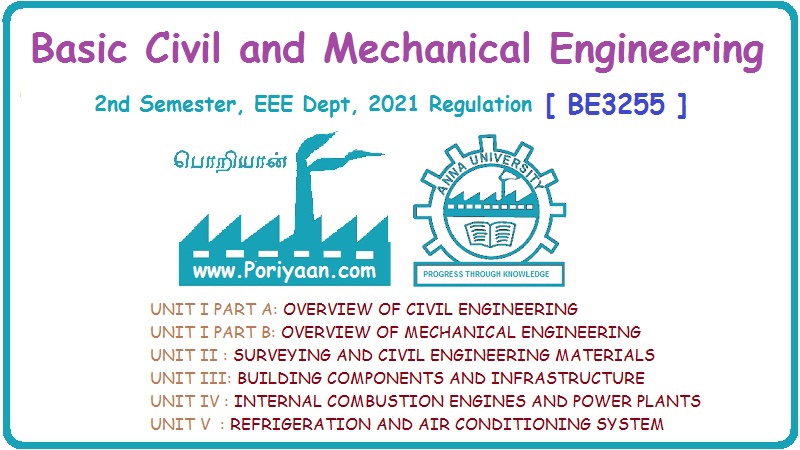Basic Civil & Mechanical Engineering: UNIT I: a. Overview of civil engineering
Question Bank: Important Short Questions
Basic Civil & Mechanical Engineering: UNIT I: a. Overview of civil engineering
Basic Civil & Mechanical Engineering : Chapter - 1 : Overview of civil engineering : II. Answer the following in one or two sentences
II. Answer
the following in one or two sentences:
1.
What are the fundamental consideration in designing a structure?
2.
What do you understand by equilibrium of a body?
3.
Define the terms: (i) Stress and (ii) Strain.
4.
Brief on tensile stress and tensile strain.
5.
Define shear stress and shear strain with the aid an illustration.
6.
Illustrate the action of shear in riveted joint.
7. Brief on the bending stress in a cantilever
beam.
8.
Mention the units of the following: (i) Stress, (ii) Strain, (iii) Young's
Modulus,
(iv)
Modulus of Rigidity and (v) Bulk Modulus.
9. Give the relationship between the three
moduli of elasticity.
10.
State Hooke's Law.
11.
Define longitudinal strain and lateral strain.
12.
What is Poisson's ratio? Give its limiting value.
13. What is Poisson's ratio? What is its
significance?
14.
Define the following terms: (i) Yield Stress (ii) Working Stress
15. Define the following terms: (i) Ultimate
Stress (ii) Factor of Safety
16.
What is factor of safety? What is its significance?
17.
State any three factors on which the factor of safety depends.
18.
What are the various sub-disciplines of Civil Engineering?
19.
Mention two responsibilities of a civil engineer.
20. Classify the external forces acting on a
structure.
21.
Why is excavation necessary?
22.
Brief on arches.
23.
What are civil works?
24.
Distinguish between civil works and building services.
25.
What is scaffolding?
26.
Distinguish between the false-work and formwork in construction.
27.
Mention the requirements of plumbing systems in buildings.
28. Soils are multiphase systems. Why?
29.
How are stresses at a point in a soil layer induced?
30. Differentiate between residual soils and
transported soils.
31. How is settlement calculated prior to
construction of foundation?
32. Why should engineers understand the nature
of shearing resistance of soil?
33. What is geotechnical engineering?
34.
What is the significance of effective stress in geotechnical engineering?
35. Name four geotechnical applications where
lateral earth pressure needs to be considered.
36.
Differentiate between soil mechanics and soil engineering.
37.
Distinguish between mechanical and chemical weathering.
38. Outline the purpose of subsurface
explosion.
39.
Mention four functions that influence the lateral earth pressure.
40. How does compression of soil take place?
41.
Mention two aspects which require through understanding of environmental
engineers.
42. Mention any two responsibilities of an
environmental engineer.
43.
Mention any two activities where environmental chemists are involved.
44. What does chemical risk assessment refer
to?
45. What does eco-hydrology deal with?
46.
Mention any two typical failures of hydrologic cycle.
47.
Mention any four attributes required for precipitation to form.
48.
Mention any two issues addressed by artificial recharge techniques.
49.
Mention four equipment commonly used in building construction practices.
50.
List the various types of building services.
51.
Distinguish between concrete structure and steel structure used in
construction.
52.
List any four applications of hydrology in engineering.
53.
List any two methods used in water resource planning.
54. What is the importance of transportation
in real life?
55.
What are the characteristics road transport?
56. Distinguish between rigid and flexible
pavements.
57. How would you classify traffic signals?
Basic Civil & Mechanical Engineering: UNIT I: a. Overview of civil engineering : Tag: : Basic Civil & Mechanical Engineering: UNIT I: a. Overview of civil engineering - Question Bank: Important Short Questions
Related Topics
Related Subjects
Basic Civil and Mechanical Engineering
BE3255 2nd Semester 2021 Regulation | 2nd Semester EEE Dept 2021 Regulation
